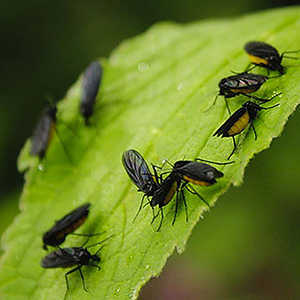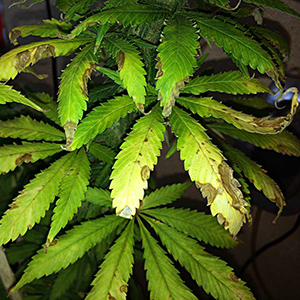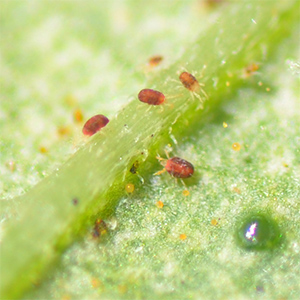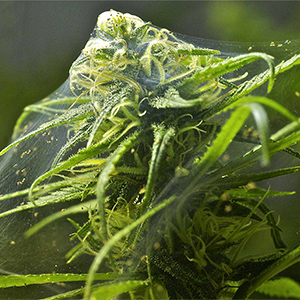Common Grow Room Pests
The following insect pests are common to the indoor grow room. More often than not when a new gardener is having a problem in the grow room, the problem is misdiagnosed as a nutrient issue. The damage caused by some of these insects can look very similar to nutrient lockout or a pH issue.
Indoor gardeners have many options to control insects. Cleanliness and prevention are the top 2. An insect problem that isn’t put in check immediately will lead to disease and crop failure. Natural-organic sprays like neem and pyrethrum work very well for many insects, resulting to chemicals should be a last resort.
Spray plants as little as possible and only use contact sprays that are approved for edible plants. Seedlings and cuttings should not be sprayed before they are a month old and have rooted. Hopefully, if you have been attentive to the garden and watch closely for any of the signs of an insect problem, you will have things under control prior to initiating the flower cycle. But if you are having a tough time of it, definitely avoid spraying during the last few weeks of flowering. If your problems are extreme, your best solution will be to destroy your plants, thoroughly clean the room and wipe everything down with a 5% bleach solution.
Fungus Gnat
Fungus Gnats infest the growing medium and roots near the surface. They eat fine root hairs and scar larger roots, causing plants to lose vigor and cause foliage to display characteristics of nutrient deficiency and disease. Common foliage conditions include paling and necrotic spots along the leaf margins and across the leaf surface. Root wounds will invite fungi like Pythium and Fusarium especially if the growing medium is soggy from overwatering or if the plants are nutrient stressed.
Prevent and eliminate fungus gnats with the following:
- Use Gnatrol (BTi-Bacillus thuringiensis israelensis bacteria) to drench the growing medium. May require multiple applications. This should be done even if you don’t see them, by the time you do they have already caused damage.
- Avoid soggy growing mediums – let the top 2 inches of the growing medium dry between waterings.
- Use yellow sticky cards placed at the growing medium surface to catch any gnats that have hatched and escaped the growing medium.
Spider Mites
Spider mites are the most common pest found on indoor plants and cause the most problems. They are usually found on the undersides of leaves where they attack and feed off of the plants fluids. This feeding causes stippling, small spots seen on the top side of the leaf surface. If left untreated, a spider mite infestation will progress relatively quickly.
There are a few different species of spider mite, but all do the same amount of damage. Thankfully, if you carefully inspect the garden on a regular basis, you can catch this pest and immediately spray down all plant surfaces with a neem spray. Neem works great at eliminating spider mites as well as some other pests and various fungi like powdery mildew.
Spider mites thrive in warm and dry environments. Reducing grow room temperatures to 60°-70° F (10°-21° C) will discourage reproduction.
Mealy Bugs
Often, the mealy bug is introduced to the grow room by the gardener. Bringing store bought plants into the grow room, or visiting the grow room after a walk in the yard can transfer this pest. Thankfully, mealy bugs are easy to control and don’t present a large scale problem like spider mites. Physically removing small numbers with a small implement or a q tip dipped in rubbing alcohol is an effective treatment. Larger populations can also be easily eradicated with homemade insecticidal sprays, pyrethrum, and neem.


Aphids
Aphids suck plant juices from the leaves, causing severely affected leaves to wilt and die. This pest is known for transferring bacteria, fungi, and viruses to infested plants. Manual removal by crushing small populations followed by insecticidal soap sprays will be very effective. Repeat insecticidal soap sprays every 7 days for 3 weeks when dealing with larger numbers to ensure their removal.


Thrips
Thrips are one of the least common insects found in indoor grow rooms. Tissue on the leaf surface is scraped away and then the juices are sucked out. Thrips are fast moving insects and can be hard to see. Often, they leave a trail of black specks (feces) on the leaf surface along with the damaged leaf tissue. Pyrethrum and insecticidal soap sprays applied twice over a 10 day period may be all that is needed depending on how well established they have become.


Whiteflies
The best way to check for whiteflies is to grab a branch and shake it. Whiteflies will fly from the undersides of the leaves if present. These pests look like very tiny moths due to their large wing structure. Whiteflies like spider mites, lay their eggs on the undersides of leaves and cause similar stippling damage that is visible on the top surface of infected foliage. Whiteflies can be easily controlled by removing damaged leaves and thoroughly spraying leaf surfaces (top and bottom) with an insecticidal soap spray at 5 to 10 day intervals. Yellow sticky cards, strategically placed in the grow room, will also help get rid of these pests.


Insecticidal Soap Recipe
The simplest insecticidal soap is nothing more than a 2% soap solution. To make this at home, you will need:
- Sprayer: Any clean spray bottle or garden sprayer will work fine for spraying insecticidal soap. Make sure the sprayer or bottle hasn’t been used for herbicides.
- Pure Soap: Use a pure liquid soap, such as Castile, or all-natural soap. The active ingredient in insecticidal soap comes from the fatty acids in animal fat or vegetable oil, so it’s important to use the real thing. Don’t use detergents (which aren’t actually soaps), dish soaps, or any products with degreasers, skin moisturizers, or synthetic chemicals. Dr. Bronner’s Pure Castile Soap is usually pretty easy to find in stores, or check your local natural-foods store for other options.
- Pure Water: Tap water is fine for making insecticidal soap. If you have hard water, you may want to use bottled or reverse osmosis water to prevent soap scum from building up on your plants.
To make homemade 2% insecticidal soap, mix together: 5 tablespoons soap to 1 gallon of water.

Neem Oil Insecticide & Fungicide
Neem oil is a very popular product in the grow room for multiple reasons. Neem works great as both an insecticide as well as a fungicide. When purchasing Neem, make sure that the product label says that it is safe for use on plants intended for human consumption. Some Neem products contain other ingredients that may not be safe for plants that are intended for ingestion.
The fatty acids in Neem work great against the soft bodied sucking insects that cause problems in the grow room. It is mainly used as a foliar spray, but can also be used as a soil drench for dealing with fungus gnats. Neem is one of the best products for dealing with spider mites when used as a foliar spray.
For foliar spray and soil drench applications mix 2 tablespoons of Neem per gallon of water. Thoroughly spray all surfaces of the leaves and stem. Make sure when applying as a foliar spray that you do it under low light conditions and that the leaves and plant materials are dry before starting a bright light daytime schedule. When used as a soil drench it can take a little time for results to show up as fungus gnats have to eat it. Water your plants with the Neem mixture as usual, but make sure to let the top 2 inches of soil dry out between waterings.

Lost Coast Plant Therapy
An expensive but effective and yet non-toxic insect remediation option is Lost Coast Plant Therapy. Effectively eliminates harmful insects and powdery mildew, without polluting the environment. Will not harm bees, ladybugs and praying mantis.





